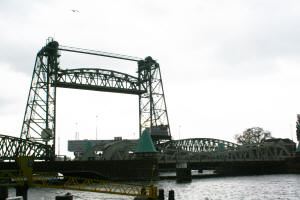| Rotterdam May 2009 Researched and led by Sue Constable |
|
|
Assembling at the waterside Maritime Hotel in Rotterdam, alongside the magnificent Erasmus Bridge, (known locally as the Swan,) the group were first led across this bridge to a converted warehouse on Wilheminapier for their introductory talk and meal. The Maritime was built in 1953 as a Zeemanshuis, a hostel, club and social centre for seamen. It still fulfils this purpose and has a small chapel within it. Several new floors were added in 2000 and many of the party had rooms on the top floor overlooking the River Maas. The area alongside the hotel was devastated by German bombing on May 14th, 1940 and our morning walk started by looking at the way this area had been rebuilt in a very modern style since then. |
Erasmus Bridge |
|
The new Library, Metrostation and blocks of flats were all noted.
Only half of the planned innovative Cube Houses on Blaak in the Oudehaven area, designed by Piet Blom, were completed and several other housing units were designed by Blom for this area.
St Laurenskerk was badly damaged in the bombing and the restoration work was briefly examined in passing.
After lunch we crossed the replacement Willemsbrug to view Nordereiland, (North Island) which grew up in the 1870s due to the expansion of the Port. |
Cube Houses |
|
The channel on the other side of this island was designed to allow large sailing
vessels passage. To this end a lifting railway bridge was built across this
channel. Now a listed structure the railway ceased to use this bridge soon after
the war as the next bridge over the much larger Maas was destroyed in the May
14th bombing and a new line was built in a tunnel under the whole area.
Known as De Hef, this bridge is a Rotterdam landmark and in spite of a shower of rain at this point in the afternoon many photographs were taken.
Further bridges across these channels, across the mouths of harbours and even a gateway across a road and a new building built on a bridge above an earlier listed building were studied.
|
 De Hef bridge |
|
Many of the warehouse buildings on the island survive – some have been converted to shops, restaurants and hotels.
Some of those that have been demolished have been replaced by hotels and very large office blocks as well as housing complexes.
The day ended after having a closer look at the Erasmusbrug. Next morning we boarded a No 7 Tram for a short ride to the central business area and the major reconstruction work taking place at Centraal Station. Our journey continued on the No 4 tram to Delftshaven. Rotterdam had just introduced ‘chip-card’ technology to its transport network and it was interesting to see that our group coped much better with ‘touching in and out’ than the locals more used to ‘stripcard’ tickets. |
No 7 Tram |
|
Delftshaven lies on the Delftse Schie canal link between Rotterdam and Delft at the Rotterdam end.
Many of the buildings there date from the 16th and 17th Centuries and The Pilgrim Fathers attended a church service at St Anthony’s Chapel on their way to the New World.
A number of distilleries operated in this area and we were able to visit a working windmill. Returning to Rotterdam’s Het Park after lunch, we examined the ‘Free Wharf’ where boats can lie while waiting for orders without charge, the Euromast, which when built was the tallest building in the Netherlands. When that record was superseded, a ‘Space Tower’ was added above the restaurant to re-establish it. We were fascinated to see the tower being used for abseiling. |
Delftshaven Mill |
|
Between the Tower and the water’s edge lies the entrance to the Foot Tunnel under the Maas.
Running close to the road tunnel which also crosses here, we descended to the passageway and walked under the river to view the SS Rotterdam, now a luxury hotel, and one of Rotterdam’s Incinerators.
Much of Rotterdam’s waste is brought to this site by barge so a waterside incinerator saves handling.
The SS Rotterdam first sailed in 1959 to New York as the flagship of the Holland America Line. The vessel came out of service in 2000 and is being converted into a luxury hotel and congress centre. This area is still home to several grain silos and mills, serviced by barges, both in and out. The day ended with a Metro ride under the Maas to the Leuvehaven station near the hotel. |
SS Rotterdam |
|
Sunday started with a Spido cruise around the Port of Rotterdam. The official commentary was supplemented by Mike and Sue who both know the area well. It was interesting to see many of the sights we had already studied from a different angle.
Once back on dry ground we looked at the area around the hotel before once more crossing the Erasmusbrug and walking around the Wilhelminakade to end the tour almost next door to the Restaurant at which we had commenced our visit to the Netherlands. All images Copyright © Mike Constable 2009 |
Spido Boat |
